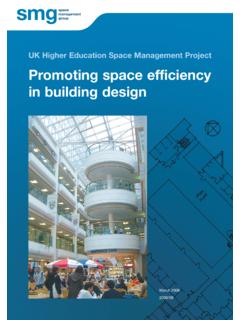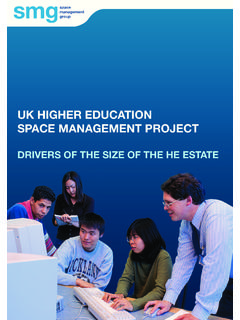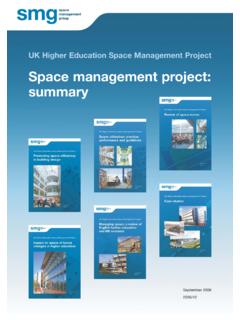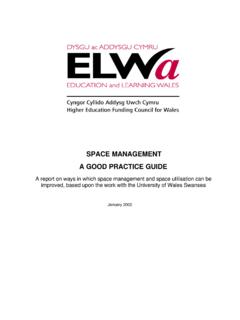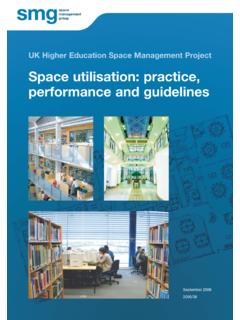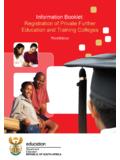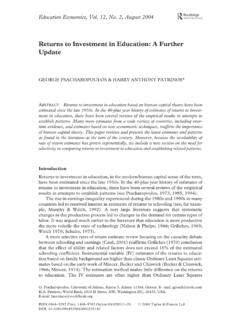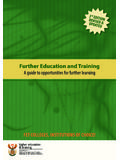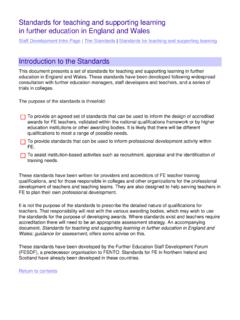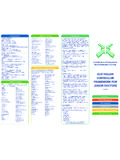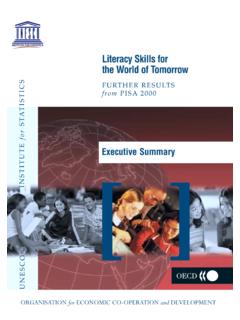Transcription of Managing space: a review of English further education and ...
1 UK Higher education Space Management ProjectManaging space: a review ofEnglish further educationand HE overseasSeptember 20062006/39 Managing space: a review of English furthereducation and HE overseasContentsPageExecutive summary3 Introduction5 The Learning and Skills Council approach6 International review15 Discussion and recommendations21 Managing space: a review of English further education and HE overseas 2006/39 1 Executive summaryScope of the studyThis study considers approaches to spacemanagement outside the UK HE sector, to seehow they might contribute to UK HE spacemanagement guidance. It investigates the methodused by the Learning and Skills Council (LSC) toassess space needs in the further education (FE)sector in England, and researches examples ofhigher education (HE) space planning andmanagement in other parts of the world.
2 Thestudy was commissioned by the UK HE SpaceManagement Group (SMG). The LSC approachOur assessment of the LSC s approach madeallowance for the differences in space needsbetween the HE and FE sectors, for example thespace requirements for research activity in highereducation institutions. The purpose of theexercise was to see if the principles behind theapproach could make an effective contributionto space management in HE and, if so, whetherany adaptations would be LSC approach is driven by the number ofguided learning hours. Guided learning hoursare broadly the equivalent of teaching contacthours in HE. The LSC uses guided learninghours as the main driver because sector-wideresearch found that the size of colleges estatescorrelated closely with the number of guidedlearning hours approach has two main components: on how individual colleges canbuild up a profile of their space needsbased on the number of guided learninghours, target rates of space utilisation andareas per workplace (for example in alecture theatre or a laboratory), dependingon the type of guided learning activity.
3 Theprofile will vary according to each college steaching and learning methods and thescope of its which can be used to calculatethe predicted size of a college s estate. Theformulae are based on the performance ofthe top quartile of colleges in terms of theirspace efficiency in delivering guidedlearning reviewOur international review focused on examples ofspace management guidance and methods inAustralasia, North America, Hong Kong andGermany. We found that a range of methods isemployed, including the publication of high levelratios of different types of space, space standardsand target utilisation rates. A number of themethods had similarities with the LSC and conclusions inrelation to UK HE guidanceMany of the space management concepts andmethods used by the LSC and researched in theinternational review are familiar to UK HEIs,although they may be expressed in differentterms.
4 However, the majority of HEIs do notroutinely build up space needs profiles based onthe volume of activity to be delivered forcomparison with space available. Such amethod would be a useful addition to currentUK HE space management guidance byproviding a means for assessing the capacity ofthe existing estate, and whether there aresurpluses or shortfalls of particular types , the availability of data to support suchan approach is an important consideration,particularly in terms of the number of contacthours. Two case studies carried out suggest thatavailability of sufficiently detailed information islikely to vary widely between SMG model for benchmarking the size ofHEIs estates, available , is already based on asimilar methodology to that used by the LSC toderive guidance areas. Research was undertakenduring the study to test the feasibility ofreplicating the LSC approach more closely, Managing space: a review of English further education and HE overseas 2006/39 3but it was concluded that the multi-variableSMG model is at present a more powerfulexplanatory recommendations are made in the light ofthis We recommend that a space managementtool is provided for the UK HE sector whichwould enable HEIs to develop a space needsprofile.
5 Given the diversity of practicewithin the sector, it is proposed that thisshould be in the form of a frameworkgiving the structure of the method, withdefault settings which can be followed oroverridden by HEIs depending on their ownindividual circumstances. further details ofsuch a method, in the form of a space needindicator framework, are set out in theSMG report review of space norms ( ).2. We recommend that the SMG model isretained in its present form as a tool forbenchmarking the size of HEIs estates,pending any significant change in the effectof key drivers of estate The LSC guidance on the total amount ofspace to be provided by colleges is based onthe performance of the most efficientquartile, in terms of the relationshipbetween numbers of guided learning hoursand total college floorspace. Bycomparison, the SMG model is based onthe average space performance predictedacross the sector for a given profile ofdrivers.
6 It is recommended that additionalinformation is provided to HEIs in updatesof the SMG model in the form of spacepredictions based not only on the averageperformance, but also on the performanceof the top quartile for a given profile ofstrategic drivers. This would provide anadditional benchmark related to theperformance of the most space efficientinstitutions in the space: a review of English further education and HE overseas 2006/39 IntroductionThis publication is the outcome of a studyconducted by Kilner Planning and LondonEconomics. The brief for this study was Learning and Skills Council (LSC) hasdeveloped an approach to help further educationcolleges in England to assess space needs. Oneobjective of this higher education (HE) spacemanagement study was to look at the extent towhich the approach could be applied or adaptedto HE.
7 The brief was also to research examplesof international HE space management methodsand guidance, and to investigate whether otherapproaches could add value to UK HE spacemanagement guidance and study is part of phase two of the SpaceManagement Project (SMP). The project is underthe direction of the UK HE Space ManagementGroup (SMG), supported by the four UKfunding bodies for higher education : the HigherEducation Funding Council for England(HEFCE), Scottish Funding Council (SFC),Higher education Funding Council for Wales(HEFCW) and the Department for Employmentand Learning (in Northern Ireland) (DEL).Scope of the reportThe report has three main sections. The firstfocuses on the LSC method. The secondinvestigates international practice. The final partdraws together the conclusions of the researchand discusses the scope for additions to the UKspace management space: a review of English further education and HE overseas 2006/39 5 Overview of the UK HE space management projectAll published reports, and previous research mentioned in this document, are available on the web oneReview of practiceJuly 2005 Drivers of the size of the HE estateJuly 2005 The cost of spaceJuly 2005 Phase twoPromoting space efficiency in building designMarch 2006 Impact on space of future changes in higher educationMarch 2006 Managing space: a review of English further educationSeptember 2006and HE overseasSpace utilisation.
8 Practice, performance and guidelinesSeptember 2006 review of space normsSeptember 2006 Space management case studiesSeptember 2006 Space management project: summarySeptember 2006 The Learning and SkillsCouncil approachFrom the outset of the research into the LSCapproach, it was recognised that there areimportant differences between the higher andfurther education sectors. A key difference is theresearch activity in HE. The focus of the studywas on assessing whether the principles behindthe LSC approach could make a contribution toeffective space management in part of the report begins with anintroduction to the LSC approach, thebackground to its development and the way thatit is used in the English FE sector. It describes itsmain components and compares it with HEguidance and practice. During the study, case study work was carriedout into the application of its main principles intwo HEIs.
9 The findings of the case studies arediscussed, together with the outcome of somesector-wide modelling of space calculations usingstatistical methods similar to those employed bythe to the LSC approachThe LSC approach provides guidance to collegeson how to assess how much and what type ofspace they need. The central driver underpinningthe approach is the volume and type of guidedlearning activity that needs to be accommodatedon site. This is measured in terms of the totalnumber of guided learning hours to be deliveredover the academic year. Guided learning hoursare defined by the LSC as: All the times when a member of staff is presentto give specific guidance towards the learningaim being studied on a programme. Thisdefinition includes lectures, tutorials andsupervised study in, for example, open learningcentres and learning workshops.
10 It also includestime spent by staff in assessing a learner sachievements, for example in the assessment ofcompetence for National VocationalQualifications. It does not include time spent bystaff in the day to day marking of assignments orhomework where the learner is not present. Itdoes not include hours where supervision orassistance is of a general nature and is notspecific to the study of the learner. Guided learning hours are broadly the equivalentof teaching contact hours in higher collect this information to make anannual return to the LSC as part of theindividualised learner record for each approach to space needs has two maincomponents. The first is advice on howindividual colleges can build up a predictedprofile of their space needs using guided learninghours, which can then be compared with whatthey have now.
